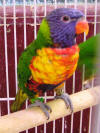. rainbow lorikeet

Aviary Notes: Level Of Knowledge Required: Beginner / Intermediate / Advanced / Specialist Breeders Only. Government Regulations & By-Laws: Refer to " Government Laws " web page. Housing Requirements: Refer to " Lorikeets & Lories " web page for general details on the housing of Lorikeets & Lories or read on for specific details for this parrot. Best kept one pair per aviary due to their aggressive nature. Has been successful as a colony in a large aviary. Young can be the subject of attack in a colony situation and may have to be removed as soon as they fledge. Not to be housed with the Red collared Lorikeet or the Scaly breasted Lorikeet due to the possibility of hybridization. A suspended cage is popular for these birds. An aviary of about 3 metres (10 feet) long is ideal for these birds. Suspended cage size should be at least 1200mm long, 900mmwide and 1200mm high (4 x 3 x 4 ft). The suspended cage can also be about 3 metres long. A wide range of bird toys and "bird gyms" can be seen at good retail bird dealers and pet shops. Bird toys and "bird gyms" can be placed in an outdoor aviary not just indoor cages. Most parrots, including Lorikeets, love to play with bird toys and "bird gyms" and it gives them a reason to be active and entertain themselves. Along with the physical activity, it also gives them some mental exercise and mental stimulation i.e. environmental enrichment. The Rainbow Lorikeet is best kept as one pair per aviary but has been successful in a colony in a large aviary. Not to be housed with the Red collared lorikeet or the Scaly breasted lorikeet due to the possibility of hybridization. Diet / Feeding: Refer to " Lorikeets & Lories " web page for general details on the feeding of Lorikeets & Lories or read on for specific details for this parrot. As per "Lorikeets & Lories" web page. Typical lorikeet diet is required. Many quality commercial dry mixes are available from bird dealers, pet shops and bird clubs. The use of wet and dry mix requires daily attention to thorough cleaning and hygiene. Abide by the "use by date" and store according to the manufacturers directions. Special attention has to be paid to the water bowl as lories and lorikeets often deposit food into the water bowl. The wet food mix should be removed from the cage before dark. The birds should not have access to wet foods left in a cage overnight. Dry food mix must always be available. The Rainbow Lorikeet is partial to fruits such as apple and
pear. These fruits are crushed in the beak and the juice is consumed and the
non fluid portion discarded. Nesting: A basic overview only. Dimensions are typical / average and can vary widely, influenced by the owner's preferences and the birds preferences. Parent bird's preferences can also be influenced by the size and type of nest-box / log in which the bird was hatched and reared. If space allows, offering a choice of sizes and types of logs or nest-boxes, and placed in various locations within the aviary, can allow the parent birds to make their own choice. Once a pair has chosen a specific nest-box/log and been successful in it, offer that one to them each breeding season. Try and keep that one for their exclusive use. Once a pair has chosen its log or nest-box, the other ones can generally be removed. If the "spare" boxes are to be removed and moved to another flight, ensure the log / nest-box is cleaned to ensure the receptacle has the minimal contamination of mites, parasites and pathogens.
Nest boxes are easy to clean, cheap
and easy to replace when they become soiled or damaged. More details on parrot nestboxes/logs and a selection of parrot nestbox/log photos can be found on the "nests", "parrot nests" and "parrot nestbox photos" web pages. Click on "Up" then "Nests" then "parrot nests" and "parrot nestbox photos" in the navigation bars. Breeding: Egg Colour White. Clutch/s per year 2, or more if conditions are suitable. Eggs per nest 2. Incubation approx. 24 days. Fledge approx. 8 - 9 weeks. Independent approx. another 1 - 2 weeks. Nest inspection of the Rainbow lorikeet is easy and generally well tolerated especially in birds housed in cages. Pair bonding is generally strong. Aggression can often be observed between newly introduced birds and if a pair (particularly the hen) is not compatible, injury or death of one bird can occur. Most parent Rainbow Lorikeets are tolerant of nest inspections and will allow the nest material to be changed while the young are still in the nest if the nest is fouled by the babies waste. Wet, cold and probably smelly nest material can be detrimental to the health and growth of the young and its removal and the placement of new nest material is worth the effort. Generally good prolific breeders. Both parent birds feed the young. Young can be hand raised for the pet or companion bird trade. Artificial incubation and hand rearing or fostering will not be covered on this web site. It is too complex and diverse in nature to be attempted here. Health Issues: Refer to "Avian Health Issues" web page for information and references.
General References: Refer to references listed on "Book References" web page. Specific References:
|